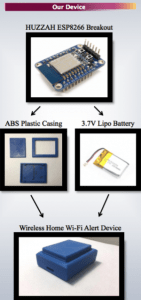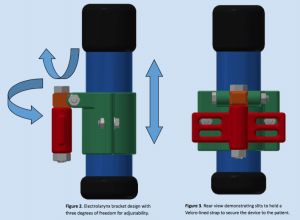The RERC on AAC partnered with four student engineering Learning Factory teams at Penn State University in the fall of 2016. The student teams met with David McNaughton on a weekly basis, and developed engineering solutions to communication related challenges. All students were undergraduates in biomedical engineering, computer science, computer engineering, and mechanical engineering. All projects were presented at the Penn State Learning Factory showcase, and will be submitted to the RESNA Student Design Competition for 2017.
 Using Head-Tracking and Eye Movement to Control a Cursor in a GUI: The Penn State student team of Ikenna Okafor, Nathan Scribano, David Sun-chu, Hui Xu, Susmita Sanyal and Darshan Shah worked with Tom Jakobs and Ethan Williams of Invotek to address the challenge of integrating information from head- and eye-tracking technology to control a cursor using the Intel RealSense camera. The goal was to develop and evaluate multimodal input strategies to assist individuals with minimal movement ( e.g., persons with ALS, spinal cord injury) in using a computer. The students developed a working prototype solution that will contribute to RERC on AAC project D1: Developing multimodal technologies to improve access
Using Head-Tracking and Eye Movement to Control a Cursor in a GUI: The Penn State student team of Ikenna Okafor, Nathan Scribano, David Sun-chu, Hui Xu, Susmita Sanyal and Darshan Shah worked with Tom Jakobs and Ethan Williams of Invotek to address the challenge of integrating information from head- and eye-tracking technology to control a cursor using the Intel RealSense camera. The goal was to develop and evaluate multimodal input strategies to assist individuals with minimal movement ( e.g., persons with ALS, spinal cord injury) in using a computer. The students developed a working prototype solution that will contribute to RERC on AAC project D1: Developing multimodal technologies to improve access
 AAC Home Wifi Alert Device: The Penn State student team of Philip Mancuso, Lucas Gramig, Moyo Williams, Tim Lagnese, Ryan Nunamaker, and the Belgium Campus (South Africa) student team of Stacey Nunez, Shane Tshabalala, and Sithembile Ngxongo worked with Anthony Arnold (a person who uses AAC) and Jessica Gormley (Speech Language Pathologist) to develop an inexpensive and durable personal alert system that could be used by persons with complex communication needs to send text messages to others during emergencies. The students developed a working prototype solution that will be further developed in upcoming Learning Factory projects.
AAC Home Wifi Alert Device: The Penn State student team of Philip Mancuso, Lucas Gramig, Moyo Williams, Tim Lagnese, Ryan Nunamaker, and the Belgium Campus (South Africa) student team of Stacey Nunez, Shane Tshabalala, and Sithembile Ngxongo worked with Anthony Arnold (a person who uses AAC) and Jessica Gormley (Speech Language Pathologist) to develop an inexpensive and durable personal alert system that could be used by persons with complex communication needs to send text messages to others during emergencies. The students developed a working prototype solution that will be further developed in upcoming Learning Factory projects.

Electrolarynx-Holder to Support Single Switch Activation: The Penn State student team of Stephen Monaco, Ian Robbins, and Dhananjay Bhaskov partnered with Dr Richard Hurtig (Voxello) to develop an Electrolarynx holder that could be used by individuals who are temporarily unable to hold the electrolarynx in position for themselves, and who need single switch activation for operation. The students developed a working prototype solution that will be shared with manufacturers of electrolarynx related medical equipment.

Single Switch Technology for Teaching Adolescents to Scan: The Penn State student team of Eric Kilmer, James Udischas, Katelyn McGee, and Meghan Reigel developed an online tool to assist adolescents with severe disabilities to learning how to scan using a single switch. The online tool supports uploading of personally relevant images, and scanning speed and the type of scanning array used can be individualized. As part of their project, the team visited the headquarters for Tobii-Dynvavox in Pittsburgh, PA. The students developed a working prototype solution that will be further developed in upcoming Learning Factory projects, and shared with manufacturers.
